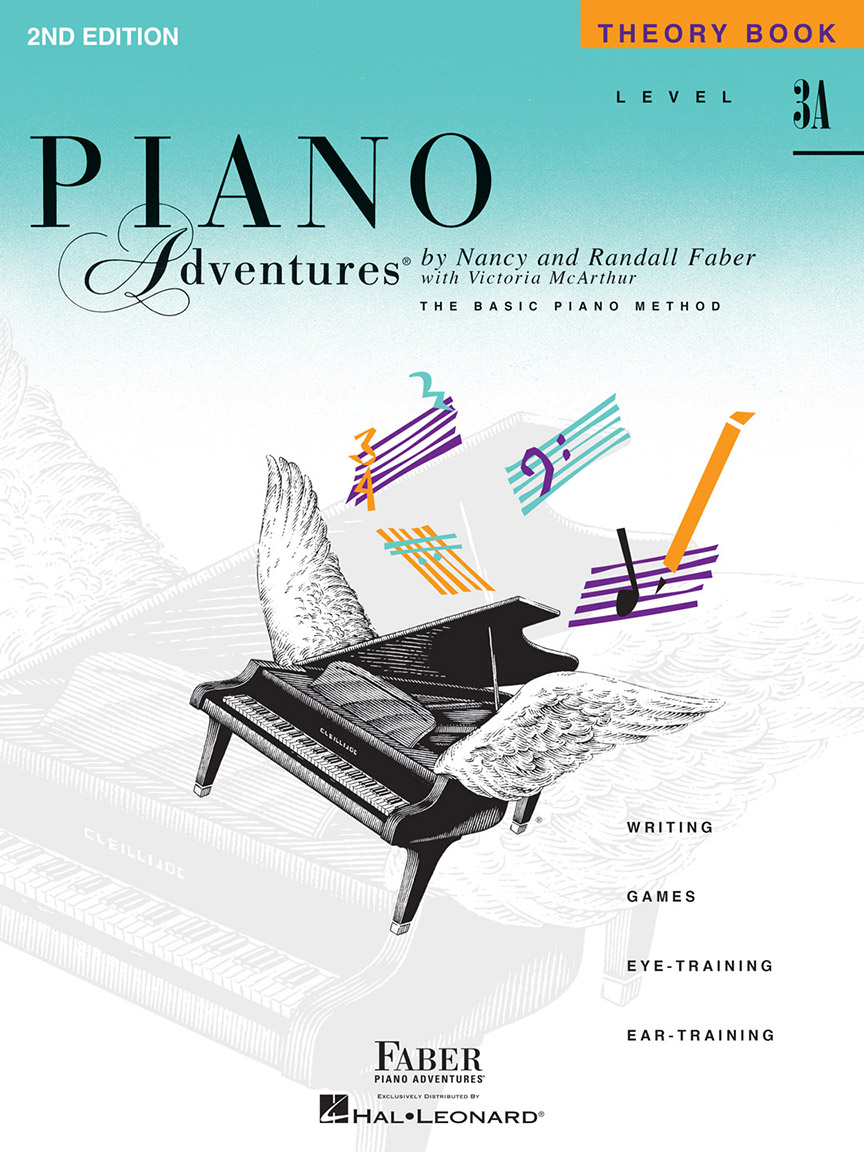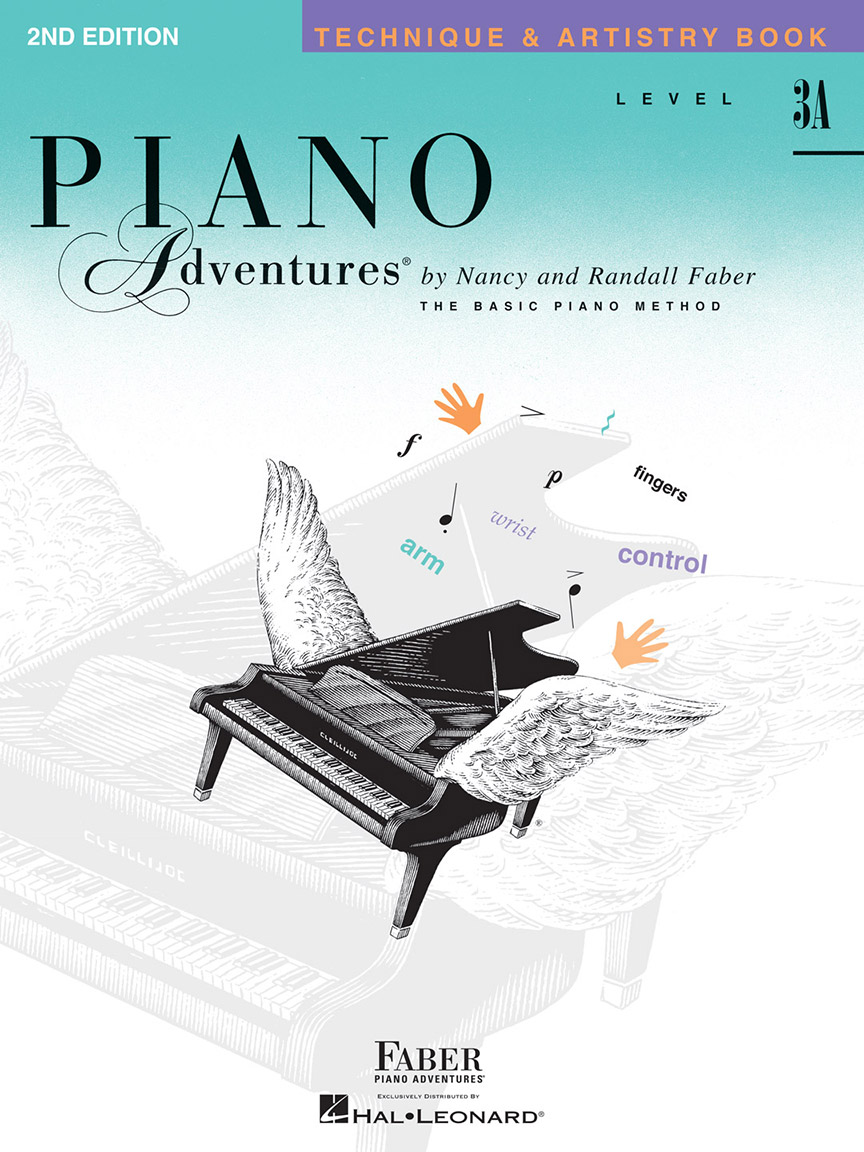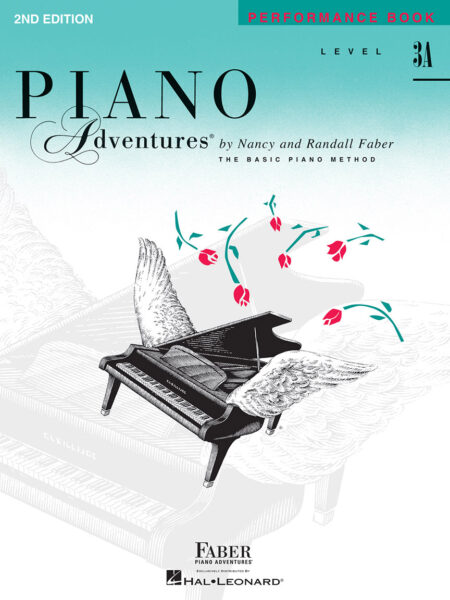
20Questions and Answers for Level 3A
About The Level 3A Books
- The Level 3A Lesson Book starts with a Level 2B Review, “Get Ready for Take-off!” Is this important to do?
- Should I use all four core Level 3A Books: Lesson, Theory, Technique & Artistry, and Performance?
- How do I fit all four 3A core books into a lesson?
- How is scale playing developed in Level 3A?
- How is transposition developed in Level 3A?
- The Alberti bass is taught on page 12. Is it time for sonatinas?
- How is the interval of a 7th treated?
- Swing rhythm is presented on page 40. Why is it important?
- How is the L.H developed at Level 3A?
- What are the Technique Secrets and how do they help?
- When should I use the 3A Sightreading Book and how?
About the Level 3A Student
- Are there any student-student duets at Level 3A?
- Should students memorize 3/8 and 6/8 rhythm patterns? (pp.26, 28)
- Where can I find more 3A lead sheets?
- What classical music can a 3A student play?
- Do 3A students compose, create, and improvise?
- What pieces could a student play for extra fun?
- Can I teach Level 3A students in an online lesson? What are some teaching tips?
About the Level 3A Adventure Learning Videos
About the Level 3A Audio Files
1.The Level 3A Lesson Book starts with a Level 2B Review, “Get Ready for Take-off!” Is this important to do?
The Level 2B Review that begins Level 3A is a handy teacher assessment tool. Use it for students graduating to Level 3A as well as transfer students. The Level 2B Review helps the teacher assess what is understood and what needs more support.
The two pages cover rhythm, time signatures, note reading, intervals, major and minor 5-finger scales, sharp, flat, tonic, dominant, and many symbols and terms.
Areas in which the student lacks confidence allow the teacher to “review and renew” understanding. Explore board work, flashcards, and cheerful questions and answers to review concepts together. Consider using the 2B Sightreading Book for students who need their reading skills strengthened as they begin Level 3A.
Level 3A Lesson Book
Get Ready for Take-off! (Level 2B Review, pp. 4-5)
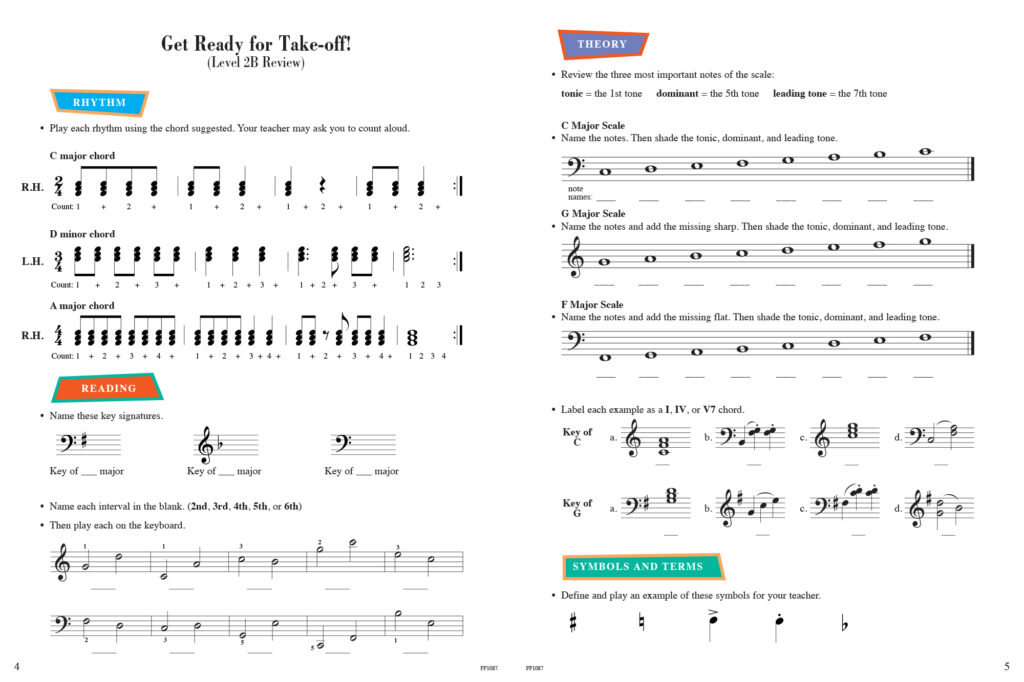
2. Should I use all four core Level 3A Books: Lesson, Theory, Technique & Artistry, and Performance?
The four core Level 3A Books form a set for wholistic learning and correlate by page number. The Theory, Technique & Artistry, and Performance Books give fresh perspectives for concepts in the 3A Lesson Book. It is possible a teacher could substitute a different solo book than the Performance Book. However, the precise tie-in of concepts in the core books is hard to beat. The early-intermediate student is making connections—connections that form the “musical mind”—and the more efficient these connections are made the better.
The core books address things easy to miss in lessons: ear-training, sightreading, improvisation, and importantly, technique for continuing skill and artistry. Taking the time for deeper learning using the four core Level 3A Books prepares students for success in Level 3B.
3.How do I fit all four 3A core books into a lesson?
The three most important books are the Lesson Book, the Theory Book, and the Technique & Artistry Book. A 30-minute lesson allows about 10 minutes per book. A 45-minute lesson, recommended for the 3A student, offers a time advantage for using all four books.
If time is short, consider demonstrating the Performance Book piece while the student watches the music. Give a few pointers, then assign to learn at home as your own “adventure piece.” This gives the teacher an opportunity to see what is easy and what is challenging at the next lesson.
For the Theory Book, the teacher might do the first example on a page with the student, then assign to complete at home. With careful lesson planning and efficient use of lesson time, the four books can be implemented, even if one book is not covered in some lessons.
4.How is scale playing developed in Level 3A?
In Unit 1 (p. 8), the C, G, and F major scales are now presented hands together. In addition, two Scale Challenges are given.
- The first challenge is to play each scale with eyes closed. Feeling the keys tactilely, without vision, attunes the student to the fingering and specific “geography” of that scale.
- The second challenge, “The Ultimate Scale Warm-up” now provides excellent H.T. practice. Students play each scale, ascending and descending, five times up the keyboard. The Challenge begins in the lowest octaves and moves 1 octave higher for each repeat. As students “shape” each scale with a crescendo and diminuendo, teachers can also coach for a small graceful lift between each octave shift.
Practicing the scales in this way gives the student a sense of command of the full instrument. Lesson and Performance Book pieces can be prefaced with the student playing the “The Ultimate Scale Warm-up” using the key of the piece.
Level 3A Lesson Book
C, G, and F Scales Hands Together (p. 8)

5. How is transposition developed in Level 3A?
When the student begins transposing outside the 5-finger position, transposition takes on new significance. Using the “ear,” thinking intervals, and relating tonic, dominant, and leading tone all build important theory skills.
An entire song, or just a portion of a piece can be transposed. Students become “keyboard smart” with short transposition workouts.
Level 3A Lesson Book
Little March (transpose to G and F, p. 9)

Looking Glass River (transpose to G, pp. 12-13)
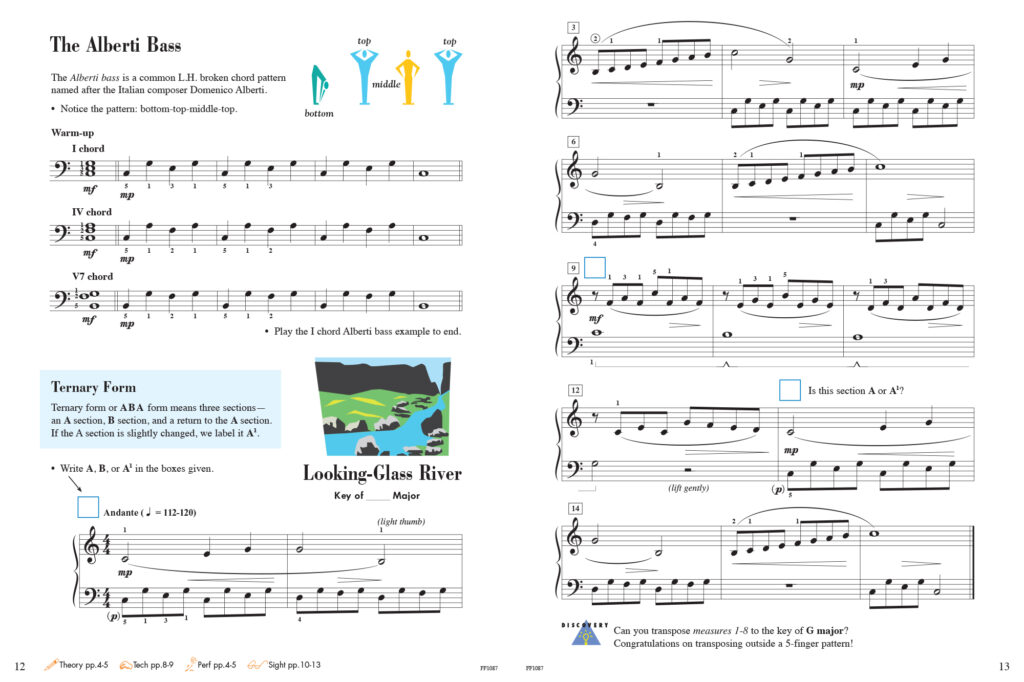
Interval Warm-up (transpose to G and F, p. 19)

Campbells Are Coming (transpose to C and G, pp. 30-31)
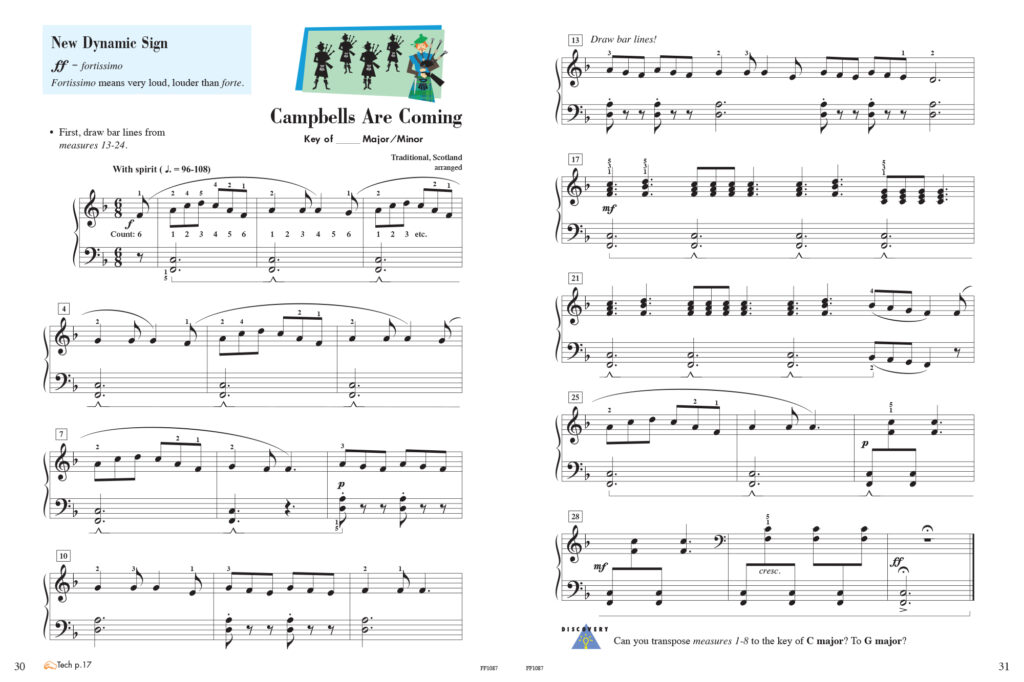
Simple Gifts (transpose to C, pp. 54-55)

Allegro in D Major (transpose to C, pp. 58-59)
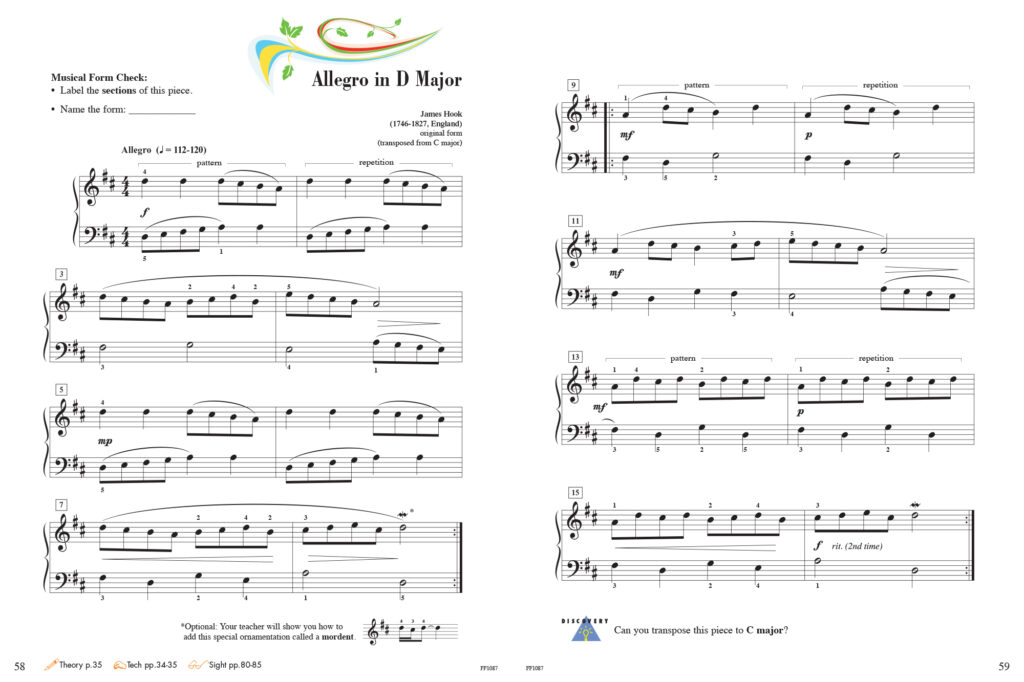
6.The Alberti bass is taught on page 12. Is it time for sonatinas?
At Level 3A, students learn a new accompaniment pattern, the Alberti bass.
Level 3A Lesson Book
Looking Glass River (intro to Alberti bass, p. 12)

The pleasing motion of the Alberti bass, replete in sonatinas, develops L.H. coordination— whether that be an allegro 1st and 3rd movement, or a lyric 2nd movement.
Sonatinas are “technique and artistry builders.” They develop balance, phrasing, dynamics, even scales, and elegant pedaling. Though it is early, some 3A students may be ready for a “sonatina challenge.” The teacher could consider these sonatinas as contenders:
Developing Artist Sonatina Book 1
Sonatina in F, Czerny (2nd movement, pp. 20-21)

Sonatina in G, Attwood (1st movement, pp. 24-25)

The Alberti bass is not only in sonatinas. Here are a few popular arrangements!
FunTime Disney Book
Be Our Guest (pp. 12-13)

FunTime RagTime & Marches
7.How is the interval of a 7th treated?
Seeing similarities with small things can bring understanding to broader concepts. For instance, we can group individual chords by similarities; C-F-G chords all being white keys, D-A-E chords, a sharp in the middle, etc.
As the 7th is introduced (p. 19), a comparison for similarities happens with the intervals of a 3rd, 5th, and 7th. We see each is line-line or space-space. Handy!
Students first find 7ths, then read 7ths, then listen for 3rds, 5ths, or 7ths with ear-training. This wholistic approach follows with blocked and broken 7ths in the pieces to follow.
Level 3A Lesson Book
7th St. Blues (p. 19)

Land of the Silver Birch (pp. 20-21)

Lunar Eclipse (pp. 24-25)

8.Swing rhythm is presented on page 40. Why is it important?
Swing rhythm is important for an understanding of musical styles— from jazz, to rock, to blues— even favorites such as “Rudolph, the Red-Nosed Reindeer” or “Swing Low, Sweet Chariot.”
Swing rhythm is also fun! It seems to relax and rejuvenate.
Teachers can use swing rhythm with technique. Consider assigning scales occasionally in swing rhythm. Sometimes a technical passage with 8th notes can be “ironed out” for wobbly fingers by playing it in “swing” as a practice step.
Level 3A Lesson Book
Cool Walkin' Bass (p. 40)

9.How is the L.H developed at Level 3A?
Left hand development expands at Level 3A with H.T. scale passages, Alberti bass, waltz bass, ragtime pattern, contrapuntal passages, primary chords in D major, and one-octave L.H. arpeggios.
Level 3A Technique & Artistry Book: H.T. scale passages
Scale Monster (pp. 26-27)

Level 3A Performance Book: waltz bass, Alberti bass, and L.H. arpeggios
Carnival of Venice (p. 2)

Long, Long Ago (p. 4)

Novela (p. 61)

Level 3A Lesson Book: ragtime pattern, contrapuntal passages
Snowflake Rag (p. 49)

Allegro in D Major (pp. 58-59)

10.What are the Technique Secrets and how do they help?
Technique at the piano requires more than finger muscles. It involves sophisticated body motion between the body, arm, wrist, and finger. We call these motions “technique gestures.”
At each level of Piano Adventures, the student is introduced to level-appropriate Technique Secrets that promote fluent playing while preventing bad habits. These “secrets” are used as daily warm-ups for the exercises that follow in the book. This combination of secrets and exercises leads to an Artistry Magic Piece at the end of each unit. These pieces allow the early intermediate student to demonstrate artistry based on fine technique learned earlier.
Level 3A Technique & Artistry has 4 Technique Secrets, each with a unique name.
- Round-off (Sighing)
- Relaxed Wrist for Chords (Wrist Takes a Bow)
- Rotation (Rocking)
- Pedal by Ear (Pedal Rhythms)
Check out sample videos of Technique Secrets here.
Level 3A Technique & Artistry Book
Level 3A Technique Secrets (pp. 2-3)


11.When should I use the 3A Sightreading Book and how?
The Level 3A Sightreading Book builds confident early-intermediate readers in two ways: recognition of individual notes and perception of rhythmic and melodic patterns.
The book is organized into sets of 5 exercises, for 5 days of practice. Each set presents variations on a piece from the Level 3A Lesson Book. Play one exercise a day, completing one set per week.
Students may begin the Level 3A Sightreading Book with the first piece in the 3A Lesson Book, “Sakura.” Integrating sightreading as the student’s skill expands builds on this important principle: Notes and chords that do not change their location on the staff are integrated into compositional patterns that do change. Permanence and change come together for musical literacy.
Here are several ways to use the Level 3A Sightreading Book.
- Teachers listen to the sightreading example for just “Day 1” at the lesson. Assign the next pages of the 5-day set to sightread at home. At the following lesson, the teacher might choose one sample “Day” from that set to hear. Then assign the next set.
- If teaching 30-minute lessons, teachers might consider using the Sightreading Book in place of the Performance Book.
- Some teachers enjoy using the Sightreading Book at the lesson to introduce a new piece. The student then learns the correlating Lesson Book piece at home as an independent study.
- The Sightreading Book can be used a final end-of-level project. Before starting Level 3B, take several weeks to assign multiple pages of the 3A Sightreading Book, supported with a FunTime Book. Students can enjoy a change of pace in their practice routine, while celebrating all the keys, chords, and rhythms they have learned.
Level 3A Sightreading Book
Table of Contents (pp. 2-3)

Looking-Glass River (pp. 10-13)


About the Level 3A Student
12.Are there any student-student duets at Level 3A?
A student-student duet can be found in the 3A Performance Book. For fun, many 3A students may be able to play a Teacher Duet from the PreTime, PlayTime, or ShowTime Books and join with a sibling or younger student in that level.
Level 3A Performance Book
Alexander March, 4-hand duet (pp. 22-23)

13.Should students memorize 3/8 and 6/8 rhythm patterns? (pp. 26, 28)
In Question 7 we discussed, “Seeing similarities with small things can bring understanding to broader concepts.”
This principle applies well in thinking with 3/8 and 6/8 rhythm patterns. Not only is memorizing the patterns great to do, but seeing how the 3/8 patterns combine together to form the 6/8 patterns brings the student into an “aha” moment.
Consider writing the rhythm patterns often (dry erase board or a piece of paper) as 3/8 or 6/8 pieces appear. Students will learn the piece faster and feel more confident in reading the rhythms.
Level 3A Lesson Book
3/8 Rhythm Patterns (p. 26)
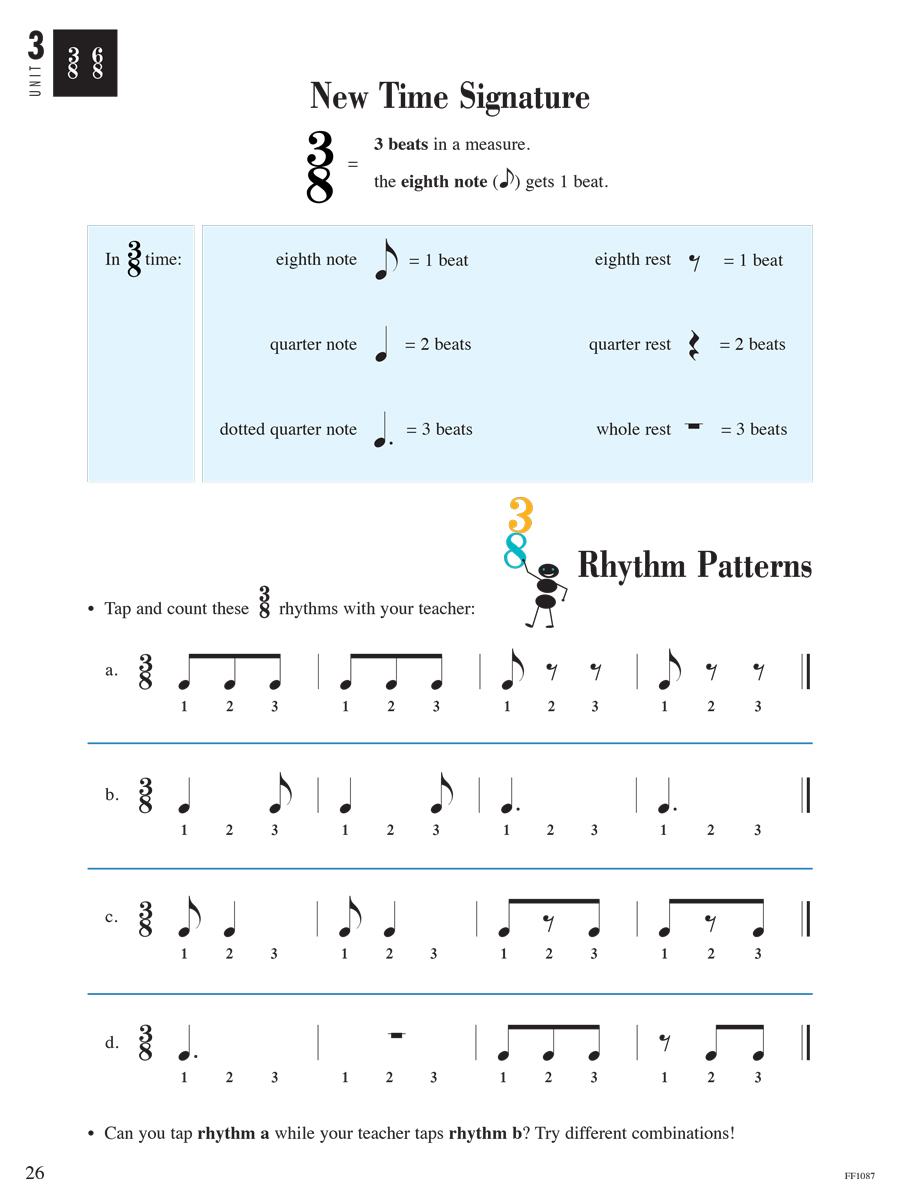
6/8 Rhythm Patterns (p. 28)
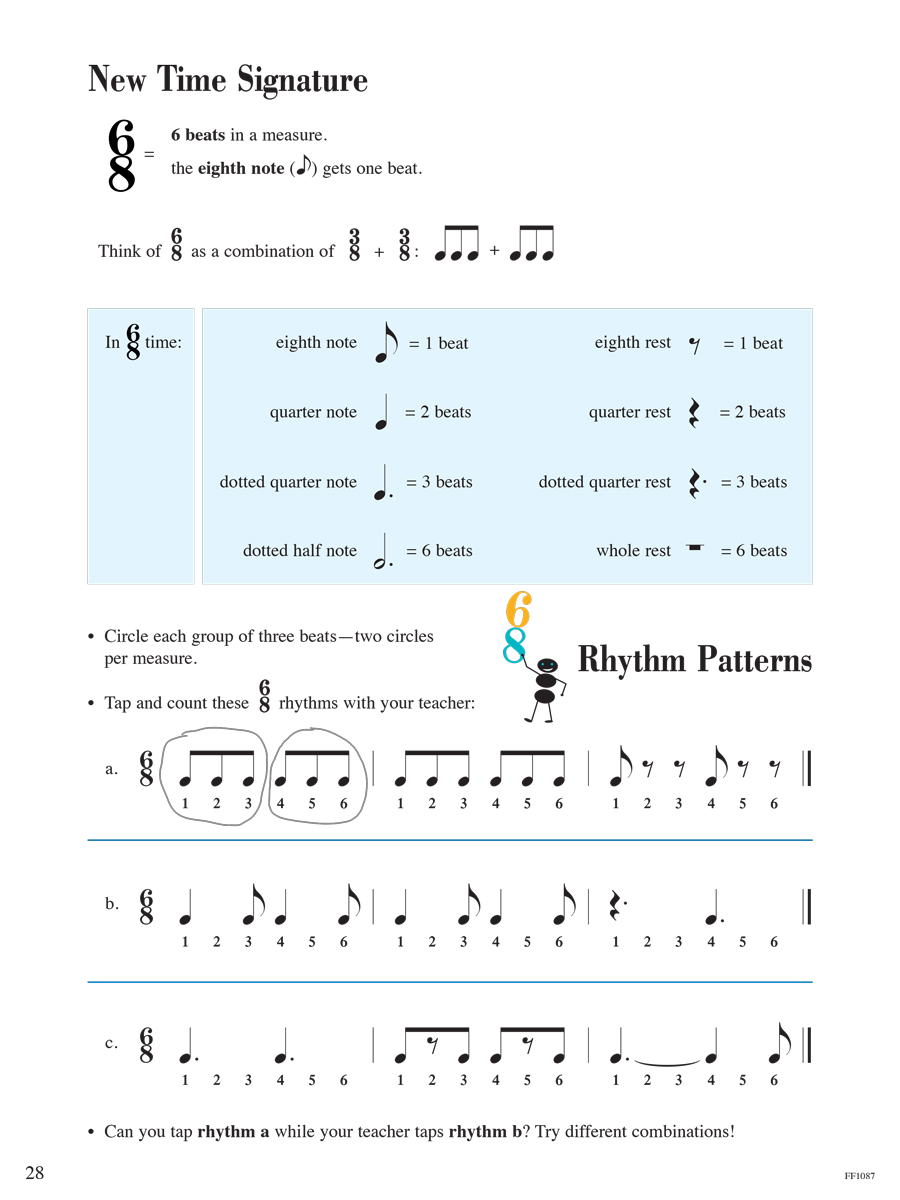
14. Where can I find more 3A lead sheets?
Lead sheets are one of the best ways ever to actively apply the theory of chords and be able to play many more pieces.
Level 3A Lesson Book
Greensleeves (lead sheet, pp. 46-47)

More Level 3A lead sheets for download are coming soon.
15.What classical music can a 3A student play?
At Level 3A, students can begin Preparatory Piano Literature or Piano Literature Book 1. The independence of the hands and opportunities for transposition offer a great review while delving into classical music. Audio tracks exist for both of these books.
A student could also explore sonatinas with The Developing Artist Sonatina Book 1. Motivated students could consider studying out of The Developing Artist Sonatina Book 2 for a much bigger challenge.
For classical themes from orchestral works, operas, and chamber music, 3A students could explore FunTime Classics.
16.Do 3A students compose, create, and improvise?
There are many opportunities to compose and improvise in Level 3A. These activities are integrated throughout the level and bring support to new concepts.
Level 3A Lesson Book: Students create an original piece using ostinato.
Land of the Silver Birch (Discovery Question, pp. 20-21)

Level 3A Lesson Book: Students create harmony with a lead sheet.
Lead Sheet for Greensleeves (pp. 46-47)

Level 3A Theory Book: Students improvise with the Chromatic and D major scales.
Music for a Time Machine (p. 30)

Canoe Ride Improvisation in D (p. 33)

Level 3A Theory Book: Students compose a melody over L.H. arpeggio patterns.
Nighttime Novela (pp. 38-39)

17.What pieces could a student play for extra fun?
For extra Level 3A fun, FunTime Piano Books offer a variety of styles with many familiar songs.

Students have a chance to:
- be adventurous applying the many things learned so far.
- have more “freedom” at the keyboard as a result.
- be more “fearless” with reading and technique basics already established.
Many students could begin a FunTime Book as early as Unit 5 in the 3A Lesson Book. At this point the interval of a 7th, cut time, 6/8 time, triplet, ledger lines, and swing rhythm have all been presented. A few FunTime samples:
FunTime Disney Book
Do You Want to Build a Snowman? (pp. 9-11)


FunTime Popular Book
The Lion Sleeps Tonight (pp. 6-7)

FunTime Jazz & Blues Book
In the Mood (pp. 4-5)

Level 3A students may also enjoy the Piano Adventures Level 3A Christmas Book. Piano Literature Book 1, Sonatina Book 1, and various Level 3A Sheets.
18.Can I teach Level 3A students in an online lesson? What are some teaching tips?
Yes, it is completely possible to teach Level 3A core books in an online lesson, such as Zoom.
The best way to do this is through subscribing to the Teacher Atlas and using its screen-sharing capability. All books in the Faber Library are available for viewing and screen sharing—including the Level 3A method books and the supplementary FunTime Piano Books.
Here are some ideas for teaching the Level 3A Lesson Book in an online lesson.
NOTE: Have the student become very familiar with the music before playing. Accomplish this through questions that require active responses from the student. Keep the discussion light, upbeat, and “congratulatory” for answers.
Let’s apply this to the first Unit 1 piece, “Sakura.” These are sample ideas. Teachers can create original questions and responses.
Level 3A Lesson Book
Sakura (p. 6)
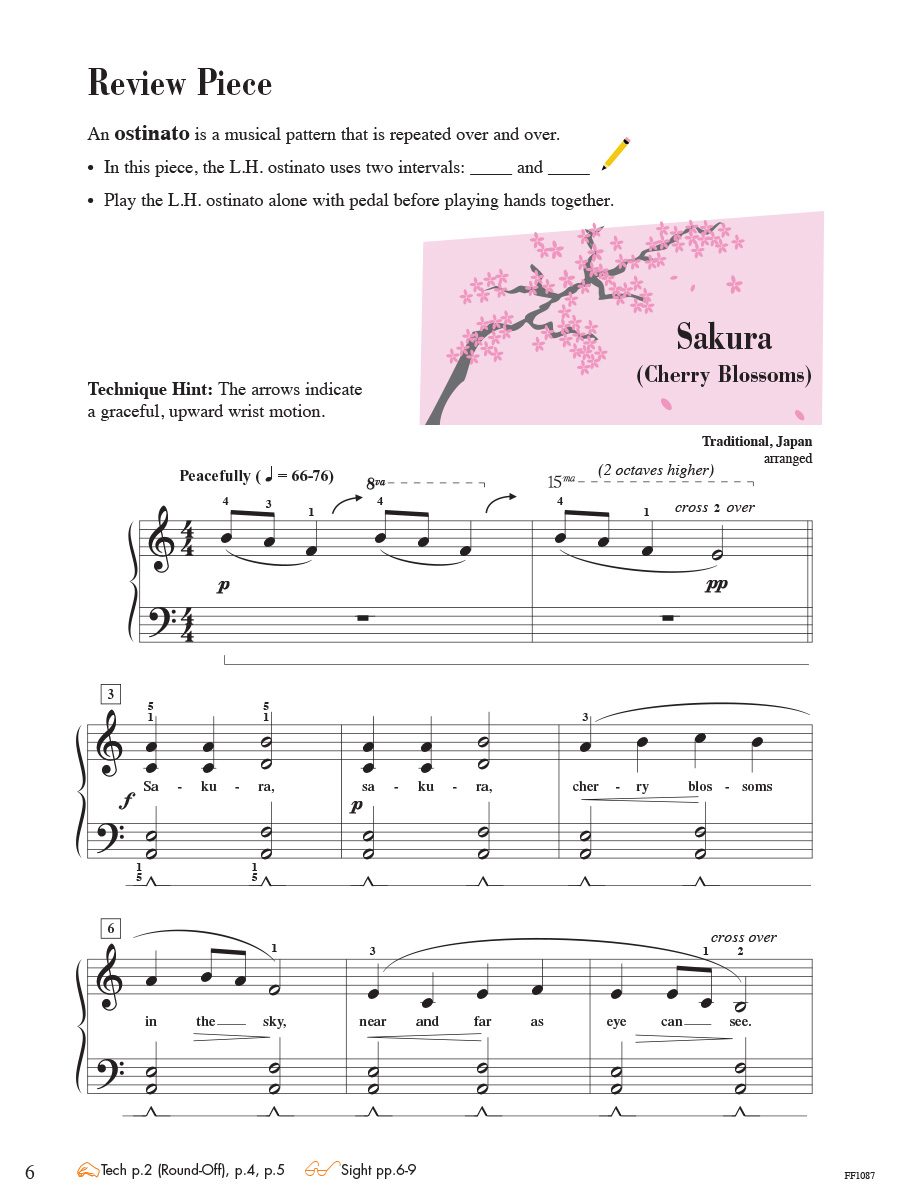
Sample Online Questions for “Sakura”
- Where do the words begin for Sakura, on line 1 or line 2?
“Yes, line 2.”
- Do you know what we could call line 1?
“Yes, an introduction!”
- Take a moment to look over the music. Does the Introduction return later in the piece?
“Yes. So now, the Introduction has become the Ending.”
- Can you read the top sentence about an ostinato?
“Good.”
- Can you name the two intervals for the L.H. ostinato?
“Yes, a 5th and a 6th.”
- How long does that ostinato continue through the piece until it finally settles on a 5th?
“Good, up to measure 15.”
- I’m going to play measures 3-6 with just my L.H. and use the pedal. (Do)
“Now your turn. Imitate the mood and play to the end of the page.”
- Now I’ll play the R.H. melody starting at measure 3 to the end of the page. Listen to me shape the phrases with crescendo and diminuendo marks.
“Now your turn to play the R.H. melody with pedal.”
- On to the next step! Will you play both hands starting at measure 3 to the end of the first page?
“Excellent!”
- This piece is rather calm. Will you play H.T. slowly from the beginning to the end? I’ll give pointers if you need it.
“Very good!”
- One last artistic detail. Listen to me play a trill on the last note. (Do)
“Will you try the trill? Good!”
- For this week, see how well you can shape the phrases, listen for clean pedaling, and have fun with the trill at the end.
“Very good!”
About the Level 3A Adventure Learning Videos
19.What are the Adventure Learning Videos?
These videos feature close-ups of the hands with simple text that taps the student’s “musical mind” with theory analysis and technique tips.
The Adventure Learning Videos for Level 3A are currently in progress and should be completed at the end of 2022. They can be very useful in a variety of ways and are modeled after the Primer Adventure Learning Videos.

About the Level 3A Audio Files
20. What are the audio files and how should I use them?
Orchestrated accompaniments for Level 3A pieces are available in the Audio Cloud and Piano Adventures Player app. Have fun exploring with your students!
Preview a track a week before teaching it at the lesson. As you listen together, discuss the sound. Is the piece happy or sad? Is the tempo fast or slow? Can you name one of the instruments that is playing?
Playing with a background accompaniment demands correct rhythm, and can be more fun than using a metronome. Students learn to feel the meter and understand the need to “keep going.” Demonstrate with the practice tempo track and point to each note in time, or chant the lyrics, finger numbers, or note names.
Many of the accompaniments encourage free improvisation on the black or white keys. These extra measures offer opportunities to create original sounds.
The musical vignettes in this series introduce the student to a variety of musical sounds and ensembles, such as the marching band, chamber orchestra, jazz ensemble, rock band, and more.



